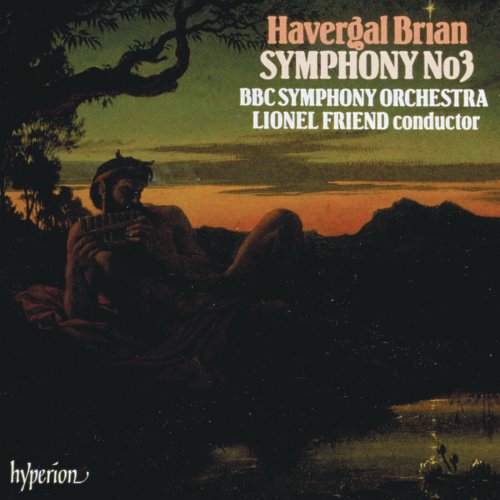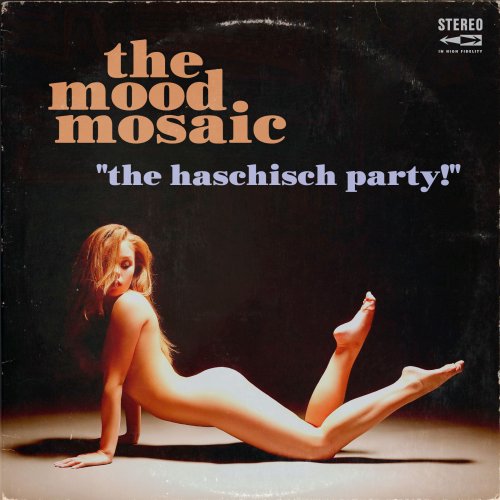BBC Symphony Orchestra, Lionel Friend, Andrew Ball, Julian Jacobson - Brian: Symphony No. 3 (1989)

Artist: BBC Symphony Orchestra, Lionel Friend, Andrew Ball, Julian Jacobson
Title: Brian: Symphony No. 3
Year Of Release: 1989
Label: Hyperion
Genre: Classical
Quality: flac lossless (tracks) +Booklet
Total Time: 00:55:12
Total Size: 215 mb
WebSite: Album Preview
TracklistTitle: Brian: Symphony No. 3
Year Of Release: 1989
Label: Hyperion
Genre: Classical
Quality: flac lossless (tracks) +Booklet
Total Time: 00:55:12
Total Size: 215 mb
WebSite: Album Preview
01. Symphony No. 3 in C-Sharp Minor: I. Andante moderato e sempre sostenuto e marcato (Pt. 1)
02. Symphony No. 3 in C-Sharp Minor: I. Andante moderato e sempre sostenuto e marcato (Pt. 2)
03. Symphony No. 3 in C-Sharp Minor: I. Andante moderato e sempre sostenuto e marcato (Pt. 3)
04. Symphony No. 3 in C-Sharp Minor: I. Andante moderato e sempre sostenuto e marcato (Pt. 4)
05. Symphony No. 3 in C-Sharp Minor: I. Andante moderato e sempre sostenuto e marcato (Pt. 5)
06. Symphony No. 3 in C-Sharp Minor: I. Andante moderato e sempre sostenuto e marcato (Pt. 6)
07. Symphony No. 3 in C-Sharp Minor: I. Andante moderato e sempre sostenuto e marcato (Pt. 7)
08. Symphony No. 3 in C-Sharp Minor: I. Andante moderato e sempre sostenuto e marcato (Pt. 8)
09. Symphony No. 3 in C-Sharp Minor: I. Andante moderato e sempre sostenuto e marcato (Pt. 9)
10. Symphony No. 3 in C-Sharp Minor: II. Lento sempre marcato e rubato (Pt. 1)
11. Symphony No. 3 in C-Sharp Minor: II. Lento sempre marcato e rubato (Pt. 2)
12. Symphony No. 3 in C-Sharp Minor: II. Lento sempre marcato e rubato (Pt. 3)
13. Symphony No. 3 in C-Sharp Minor: II. Lento sempre marcato e rubato (Pt. 4)
14. Symphony No. 3 in C-Sharp Minor: II. Lento sempre marcato e rubato (Pt. 5)
15. Symphony No. 3 in C-Sharp Minor: III. Allegro vivace (Pt. 1)
16. Symphony No. 3 in C-Sharp Minor: III. Allegro vivace (Pt. 2)
17. Symphony No. 3 in C-Sharp Minor: III. Allegro vivace (Pt. 3)
18. Symphony No. 3 in C-Sharp Minor: IV. Lento solenne (Pt. 1)
19. Symphony No. 3 in C-Sharp Minor: IV. Lento solenne (Pt. 2)
20. Symphony No. 3 in C-Sharp Minor: IV. Lento solenne (Pt. 3)
21. Symphony No. 3 in C-Sharp Minor: IV. Lento solenne (Pt. 4)
Several myths still adhere to the life, work and reputation of the English composer Havergal Brian, though some of the more unlikely statistics are not mythical at all but plain facts. He really did compose 33 symphonies (the first now being lost and discounted from the ‘official’ canon of 32); the majority of them were written at an age to which most other composers of note never lived, let alone produced some of their most significant music; and the celebrated ‘Gothic’ (No 1) is probably with justice regarded as the largest symphony ever written.
Some of the myths, however, are utter misconceptions, like the notion still held by some that the other 31 symphonies are as gargantuan as the ‘Gothic’. In fact the third recorded here, though the longest of all of these, is but half the length of its vast choral predecessor and shorter than most of Bruckner’s and Mahler’s. Also, Brian’s composing was not, as is often thought, a mere old man’s hobby, but a sustained life work extending over more than three quarters of a century. His concentration (in the end almost exclusive) on symphonic form was a characteristic of the latter half of his extraordinarily long creative career. The lost Fantastic Symphony was just one work from a respectably large body of music produced before World War I, and he did not finally take up the deepest challenges of the genre until he was well past forty.
The ‘Gothic’ emerged between 1919 and 1927. His next creative task was the orchestration of his opera The Tigers, sketched before that symphony, and after this was completed nearly a year elapsed before a second symphony began to take shape. No 2, for orchestra alone, was far more orthodox in scale and structure, though still a very substantial piece by any other standards. The full score was completed on 6 April 1931, and only six days later Brian began to sketch its mighty successor.
It seems that No 3 was not begun as a symphony. On 25 May 1931, two days after the first movement was completed in outline, Brian wrote to Sir Granville Bantock that he had ‘resolved the Concerto into a Symphony’. This is the only such reference, but it surely means that the third was initially conceived as a concerto for piano—or rather, perhaps, the two pianos that loom so large and diversely in the final score. We should also note that this first movement uses these instruments far more extensively than the other three, which were still unwritten at the time of the letter. The pianos only appear in the latter half of the Lento second movement, parts of the finale, and not at all in the scherzo (the movements were composed in that order).
On 21 June he began the second movement and completed its short score on 1 July, despite the ‘many hindrances’ complained about just over a week later in a letter to Bantock which goes on: ‘I like the second movement now—it is bigger than such as I played to you from the first movement.’ Composition of the work gathered pace: the finale was completed on 16 July after four days’ work, and the scherzo despatched in a final two-day blaze of exuberant creativity celebrated in a further letter to ‘Dear Gran’ on the 20th: ‘I finished the sketch of my new Symphony last night. As I heard the slow movement in a very slow 3—I had to evolve a 2/4 scherzo which sounds as though it had been written in Vienna … it will take a long time to decipher and write out my sketches …’
The ‘long time’ stretched to 28 May 1932 when the full score was finally completed. This was hardly surprising, given the full-time writing and editing commitments at the magazine Musical Opinion which Brian had been fulfilling since his appointment as Assistant Editor in June 1927, not to mention the sheer size of the symphony and its orchestration. The work is scored for the following array: four flutes (all doubling piccolos), four oboes (two doubling cors anglais), E flat clarinet, four clarinets in A (two doubling bass clarinets), four bassoons, contrabassoon; eight horns, four trumpets, four trombones (including contrabass), two tubas; six timpani (two players), bass drum, side drum, tenor drum, cymbals, tambourine, castanets, triangle, gong, xylophone, glockenspiel, celesta, two harps, two pianos, organ (‘ad lib’, but included in this recording) and strings (often much subdivided). For this recording the total forces numbered 120 players.
While the third symphony has its fair share of dissonance, march rhythms, angular string writing, hard-edged percussion-topped scoring and abruptly cut off climaxes—more than enough to proclaim its kinship with later Brian—other features equally hark back to moods in his earlier music: of pastoral innocence, Elgarian nobility and sheer unbuttoned fairground riotousness. Withal it remains his most expansive, objective, heroic and lyrical symphony—all characteristics in keeping with the connotations, both aspiring and celestial, of the enigmatic word ‘Altarus’, the apparent title which Brian wrote on the score and then partially erased. In more than its number, as well as the disposition and relative dimensions of its movements, this work is Brian’s ‘Eroica’ (without claiming further comparability with the greatest of all third symphonies).
A trenchant twenty-four bar introduction, growing out of an extraordinarily portentous unison C sharp octave on the pianos and doublebasses, with P gong stroke (track 1), leads to a long-breathed but curiously dour first subject melody, initially played by solo clarinet and divided strings ‘Più lento e espress.’ (track 2). After a linking passage dominated by the first piano, the first subject is repeated with fuller scoring and proceeds via a sudden percussion-driven ‘Allegro moderato’ to the B minor second subject complex, ‘Poco più lento’ (track 3). This, one of the longest and most haunting melodies in Brian’s output, passes from multi-divided strings to winds, pianos and glockenspiel, then all these together. An episode of fantastic, pointilliste flickerings (track 4), then stalking trombone chords, lead to a full restatement of the second subject, increasingly overlaid by dissonant figuration that all but obliterates the melody. This grinds to a typically precipitous Brianic impasse beyond which flute and clarinet in octaves, haunted by a staccato piano figure, uncertainly survey the landscape. Espressivo strings find a sense of direction, tension picks up, and the music crescendos into an ‘Allegro con brio’ (track 5). Formally, an extremely expansive exposition has now precipitated a kind of development section which, from wholly new material including a ‘Broad-Massive Sempre Dolente’ melody (track 6), leads—via pounding piano octaves (track 7) derived from the introduction—to real contrapuntal development of the first subject. A ‘Più allegro e con brio’ link dominated by pianos, side drum and xylophone at length brings a recapitulation crashing in (track 8). Sonata-style designs are rare in Brian, and more rarely yet does he treat us to the luxury of full-scale melodic repetitions, but here first and second subjects pass in full resplendent train (but with plenty of internal development still going on!), the latter borne aloft first by woodwind and brass choirs haloed in glistening cascades of piano octaves, then strings, ‘con molto espressione’, and lastly the full forces, driving to a peak of ecstatic, Romantic fervour. This collapses into a ‘molto marcato’ preparation by bassoons, horns and lower strings for a new and extended visitation by the rising piano octaves (track 9), four times repeated, and separated by prolonged tattoos from both timpanists. In a mood heavy with foreboding and frustrated energy, the movement’s massive coda is released—a ponderous, lurching march ‘as heavy as possible to the close.’
The first movement is not only the longest but also the most structurally complex and disturbed in the symphony. Despite its coda’s unresolved tension, however, some profound psychological conflict does seem to have been eased at the passing of the movement, for the remainder of the work exists at a far more essentially serene level. The Lento unfolds from hesitant but premonitory fragments of figures (track 10) into a lengthy exposition of melodic ideas, one of the most distinctive first heard on a solo flute and then violin (track 11, one of several places where the textures thin out to allow one instrument to carry the music forward with a single melodic line). With very little of either the agonized disjunction or the heady fervour of the first movement, the second alternates between Alpine grandeur and pastoral calm, with at its centre a long, pivotal violin solo (track 12) uncoiling against shifting melodic fragments on woodwind, horns, harp and strings, gradually exhaling all tension to a ‘sostenuto molto’ meditative quiescence, resting at last on an E. A solo timpanum repeats the E and the music moves into life again with a statement on first violins and violas of the flute/violin tune, this with almost Vaughan Williams-like candour. From now on the movement ascends through a series of glacial vistas—every department of the huge orchestra used to the utmost dramatic and colouristic effect (track 13)—to mountainous climaxes of truly Brucknerian grandeur during which the pianos, silent for most of the movement, reappear. They descend with the heavy brass through a series of giant chordal steps and, left almost by themselves at the last, usher in a beautiful, long-drawn pastoral coda (track 14). An oboe muses over familiar melodic ideas against pp lower strings, its song finally passing to a flute which sinks to rest beneath quiet brass chords.
Brian continues with what we might well expect from many a Classical or Romantic composer, but certainly not of him—a regular (almost!) scherzo-and-trio: first a brilliant fast march (track 15) enclosing a ‘Grazioso e dolce’ central section initially on flute and string quartet (track 16), then a trio that’s even more of a surprise—a lilting waltz melody (track 17) sounding as if it had strayed from the world of Viennese operetta. Nevertheless, for all its first innocence, the trio’s development proceeds with leaps and textures and trills that speak more with the accent of Richard than Johann, and when Brian brings back the march not as a literal repeat but more heavily and dissonantly scored with full wind and brass employed for the first time in this movement, it comes as no real surprise to find him cleverly drawing back step by step into the symphony’s central progress, in preparation for the finale.
Brian does not often let us into the workshops of his mind and spirit, but another letter to Bantock gives a valuable insight into the composer’s perception of the impetus behind the third symphony’s elegiac finale. After recounting his ‘keen interest in a German Professor at Heidelberg University—Friedrich Gundolf … a great fellow—who has pursued Goethe and Shakespeare all his life’, Brian goes on: ‘When I was working at the finale of my new symphony—it deviated (like its predecessor …) into an elegiac or Funeral poem. I couldn’t escape it—it had to be. After I had finished my symphony—I rushed up to town—bought a ‘Berliner Tageblatt’ put it in my bag—but didnt (sic) even look at it until Monday night this week … I was astonished to find that I had written the finale at the time of Gundolf’s death—and actually completed it about the time of his funeral in Heidelberg. It may be a coincidence—but it is a curious and sad one.’ Note the ‘had to be’ and ‘may be’.
Requiem for Friedrich Gundolf or not, the Finale’s progress from the long opening bass clarinet theme (track 18) through episodes magically remote, starkly violent, and consolatory, to the overwhelming conclusion seems in retrospect to be inevitable. The rich polyphonic growth of the first theme thickens and darkens before a ‘Poco largamente’ climax (with pianos reappearing for the first time since the second movement) gives way to offstage trumpet and horn fanfares (track 19). A slow timpani crescendo precipitates the irruption of jagged development (some of the first movement’s tensions here reasserting themselves) which in turn eventually quietens and leads to the second main theme (track 20). The tension gradually rises again, piano tone increasingly irradiates the orchestral texture, and the movement proceeds towards its conclusion in great unhurried waves—Brucknerian parallels again becoming apparent—in which both main themes are developed and extended. Finally the organ adds its voice for the first time, trombones and tubas shoulder the whole edifice beneath a veritable aviary of trills from woodwind and strings, and the climax of this massive symphony—a four-bar ‘Lento assai’ epilogue (no Baxian leave-taking this!)—explodes in a crushing affirmation of power (track 21).
Havergal Brian never heard his third symphony—which at the time of composition he described to Bantock as ‘the best of the symphonies I have written’. It was first played in a BBC studio in January 1974—just over a year after Brian’s death—by the New Philharmonia Orchestra under Stanley Pope, with Ronald Stevenson and David Wilde playing the important piano parts. It was first given in public by the Symphony Orchestra of Composers Platform, West Midlands, conducted by Paul Venn, in Birmingham Town Hall on 17 May 1987. The present recording was made at the BBC’s Maida Vale Studio 1 on 27/28 October 1988, immediately following a public performance before an invited audience.
![Mark Northam - More Music From The Pixar Films For Solo Piano (2025) [Hi-Res] Mark Northam - More Music From The Pixar Films For Solo Piano (2025) [Hi-Res]](https://img.israbox.com/img/2025-12/17/qc8ci6ocl25zt4m9ojnjn3k2k.jpg)




![Brad Keeghan - Brad Keeghan (2025) [Hi-Res] Brad Keeghan - Brad Keeghan (2025) [Hi-Res]](https://www.dibpic.com/uploads/posts/2025-12/1766078373_cover.jpg)

![Nana Vasconcelos - Saudades (1980/2025) [Hi-Res] Nana Vasconcelos - Saudades (1980/2025) [Hi-Res]](https://www.dibpic.com/uploads/posts/2025-12/1766056483_cover.jpg)
